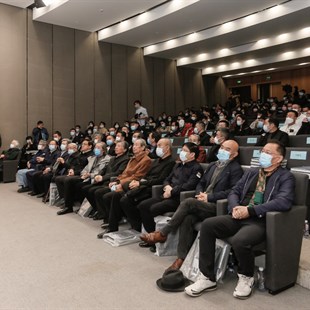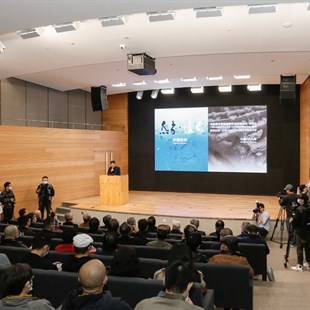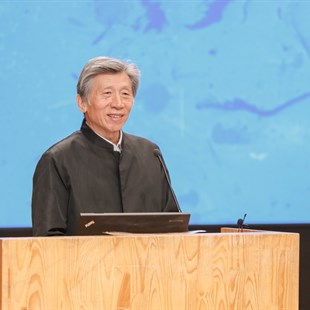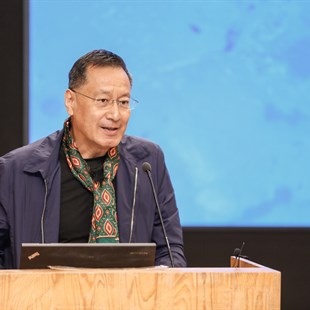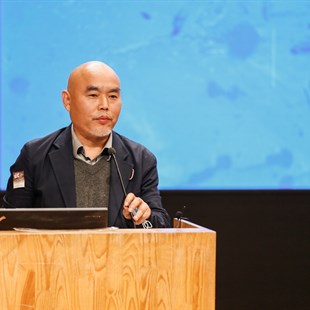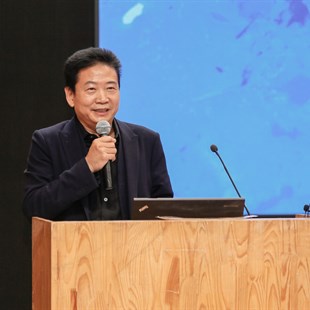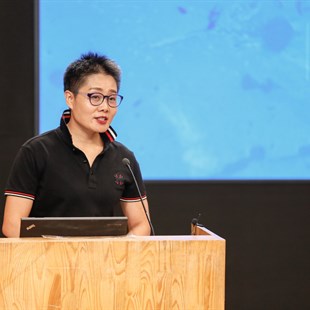
In the CAFA Annual Fine Arts Nomination Exhibition 2020, viewers can observe the encounter and interaction between the energy hidden in Ma Lu’s painting and the national spirit rooted in Lv Pinchang’s [1] sculptures. The exhibition is based on the present reviewing and researching the creative context of Ma Lu and Lv Pinchang over the past few decades. Meanwhile, it also explores the two artists’ artistic thinking, which came from a traditional context and has always been in the process of absorbing and merging foreign cultural thoughts.
On the occasion of the opening of the exhibition, CAFA ART INFO has specially interviewed artists Ma Lu and Lv Pinchang. The interview starts with the concept of the exhibition theme and then explores several topics based on their respective art careers, such as contemporary and traditional, absorbing and merging, life and energy, form and feeling, creation and expression, etc.


Exhibition View
“The Image of ‘Qi’” and Ma Lu

Ma Lu "That Far" Acrylic, Mixed Media on Canvas 210cmx280cm 2010

Ma Lu "That Wave" Acrylic, Mixed Media on Canvas, 280cmx210cm 2010

Ma Lu "Asymmetric Space" Acrylic, Mixed Media on Canvas, 2014
CAFA ART INFO: Hello, Professor Ma. In this exhibition, the phrase “The Image of ‘Qi’” is used to summarize your creative connotation over the last decade which is different from the typical labels such as “abstraction” and “imagery”. Can you share your understanding of this phrase with us? How does it connect with your creation?
Ma Lu: It is difficult to classify one's art. Because the changes in works and thoughts in the past are beyond any existing concepts. The main reason for achieving a breakthrough is to make myself live more meaningfully and more interested in thinking. In other words, I intend to find meaning in “interesting” activities. Not all interesting activities are meaningful, but meaningful things are always interesting. If it is boring—first, if a meaning was fake, then boredom is inevitable; second, if people had no ability to discover a meaning, although the process is interesting, it might unavoidably become boring.
Why we need to summarize one’s past? Is it because of the poor ability in observing things to make oneself always feel bored?Therefore, it’s necessary to change oneself? In fact, it is not due to the poor ability, but because of too much covering. Nor is it the fault of knowledge itself, but because I thought knowledge is fixed and I regard specific knowledge as the whole, forgetting that knowledge is only in the process of discovery. It is far from being saturated. The process of discovery is the process of knowledge construction. The premise is to remove the cover and not to restrict the past knowledge. Concealment is used in the wrong place. In art, there is no overthrowing and repeating, but different relationships that tell various things.

Ma Lu "Turbid Wave Crushing into the Blue Sky" Acrylic, Mixed Techniques on Canvas, 110×210cm, 2017

Ma Lu "Clear the Delusion" Acrylic, Mixed Techniques on Canvas 110cm×210cm 2017
I neither want to deliberately dig out nor give intentional meaning to art. Art should be logical, rather than being forced to endow any meaning. The reason is kept in my mind. Therefore, the visual appeal ranks first, the name is created and the concept then follows. The various differences in vision are used to inspire ideas and further allow a vision to have an independent value. The concept “The Image of ‘Qi’” is not Taoist enlightenment, but from the outside to the inside, to explore the root of the image. This root is called energy for the time being. It is understood by the energy that all things in nature take shape.
CAFA ART INFO: The exhibition presents three series of your work, namely, “That Series”, “Listening Series” and “Overlapping Series”. These are also the three stages of continuous excavation and deepening in your artistic exploration. Can you talk specifically about the creation and thinking of these three stages?
Ma Lu: This idea was gradually formed over the past ten years. Using curator Hongmei’s classification, it can be divided into three stages. “That Series” regards painting as a scene from the other shore, which is the contemplation of the soul, while “Listening Series” explores painting as invisible but perceivable. Listening refers to any other perceptional experience except for vision. The third is the “Overlapping Series”, which regards perception as a superimposed experience. After superimposition, a new form is produced, the unpredictable vitality is given birth after embracing it. It is difficult to clearly distinguish these three stages. The details are the result of literal reasoning. When implemented in visual works, there would be repetitions, perhaps due to the lag in understanding. The three stages are presented layer by layer, from simple to complex.
CAFA ART INFO: Through reviewing the creation and thinking from 2010 through to 2020, do you have any new experience in techniques, expressions, and emotions?
Ma Lu: I have been trying the creative method without design and inspiration and to allow the picture to be self-directed. So, painting tells me what is significant. What I want to do is to listen to it and assist it in its completion, not to force it or distort it. In this case, personal self-cultivation and the mind become vital. The natural and originally meaningless stuff can be recognized if it was endowed with significant base which was valued highly by people. Any meaning in art is given by people. This is the reason why art cannot be used to make a living, but it is invaluable at the same time. The discovery of meaning replaces the position of techniques, expressions and emotions, becoming “capitalized” techniques, expressions and emotions on another level.

Ma Lu "Joy" Acrylic, Mixed Techniques on Canvas 100cmX160cm 2017-2019.10

Ma Lu "Hua" Acrylic, Mixed Techniques on Canvas 100cm×140cm 2017
CAFA ART INFO: I have observed that there are short paragraphs of text as inscriptions on the reverse of your many paintings. How do you form this explanation?

Exhibition View
Ma Lu: What did I find? I discovered the desolation of the other shore and the limitation of perception, overlapping with freedom and blurred notions. The human being in front of the picture is the totality from the macro to the micro, while the eyes receive the picture in its entirety. We cannot and should not control the understanding and imagination of others when they see the pictures. It is vitality that is born in everyone’s inner heart, and it is also the process of discovery. If we don’t put too much emphasis on what we have discovered, the process of discovery would show its significance. People will make continuous progress on the continuous discovery. In the end, “discovery” itself is the most meaningful, “discovery” is meaning, and the results of discovery are all small meanings attached to the big meaning of “discovery”. Without discovery, no small meanings can be generated. Discovery is active and cannot be forced.
There will be discoveries in any field, which will bring us the significance of how to live well, but there are relatively few restrictions in painting. This is why I gradually fell in love with painting. After understanding the meaning of discovery, people can do many pleasurable things. I found that the reverse of the work was beautiful, but a little empty, so I wrote some words about the picture, about the past, about thinking, etc. Handwriting has been practiced from a young age, from the regular script, official script, and running script to seal cutting. I love reading, and I often write freely in the blank spaces of the book, leaving my traces on books. Behind the painting, there can also be a trace of its own, and the inscription and calligraphy can echo cultural traditions. The connection between these things needs to be rediscovered. The so-called deepening is also a form of discovery. There are more restrictions in seal cutting. How to be free from restrictions is a more interesting observation.

Ma Lu "Qing Ping Miao Luan" and its inscriptions, Acrylic, Mixed Techniques on Canvas 90cmx130cm 2017-2020.06

Ma Lu "A Little Hump" and its inscriptions, Acrylic, Mixed Techniques on Canvas 180cm×210cm 2014

Ma Lu "Clouds in the Sunset" and its inscriptions, Acrylic, Mixed Techniques on Canvas 90cmX120cm 2016
CAFA ART INFO: The work “The Image of ‘Qi’” has been painted for ten years, which ends in the year 2020. Can you talk about the background of this piece? What prompted you to end the long creation of this work this year?
Ma Lu: Ten years ago, I entitled this piece “Ice Wind”. I neither finished it nor exhibited it at that time. Ten years later, I feel like I think it through. I should regard works over previous days as the basis and background, rather than modifying them. Therefore, “The Image of ‘Qi’ does not appear without any foundation. Instead, it does have some sort of accumulation. The accumulation, whether “right” or “wrong”, will merge into a new “Image”. Each level of stubbornness requires us to find the rational for it. The finding is discovering. And we discover new stuff in the overlap.
CAFA ART INFO: The word "discovery" has been mentioned by you many times. You are considered to be one of the earliest young painters who studied “German-style” art after the reform and opening up in China. However, you later abandoned the style of Neo-Expressionism and gradually went out of your way. How did you discover, uphold, and develop in the process of convergence, conversion, and integration of different styles?
Ma Lu: The painting can be drawn after ten years and the inscription can also be written after ten years. Ten years has become ten minutes. Is this life short? Is it still longer? Time can be crossed, so can space. If you are ready, the leap is natural. To live is to prepare. Being in the big time and space, you will naturally discover more.
I like the word “discover” very much. This is a state of affirming oneself and respecting the outside world. It is a state of unity of inside and outside, and it is also the most natural and normal state of man.


Exhibition View
“The Image of ‘Zhi’” and Lv Pinchang



Exhibition View

Lv Pinchang "A-Fu No.8" Clay 140x50x72cm 1993

Lv Pinchang "A-Fu No.15" Porcelain 57x42x40cm 2005

Lv Pinchang, "Bundled Forms and Structures No.3" Steel Jade Porcelain 55x45x45cm 2016

Lv Pinchang "Space Plan" Metal, Clay, Stainless Steel Exhibiting Area: 1000x120cm 2004-2020
CAFA ART INFO: Hello, Professor Lv. In this exhibition, the term “The Image of ‘Zhi’” is used to summarize your sculpture creations over the past thirty years. What do you think of the relationship between the term and your creative outlook and thoughts over the years?
Lv Pinchang: Clay always gives me a natural sense of intimacy. In the field of sculpture, especially within traditional sculpture, clay is the most common, primitive medium with numerous possibilities. Meanwhile, it is the root of ceramic materials and its basic properties determine the material properties of ceramics. The shrinkage ratio of clay and porcelain clay, the molding process, the texture of the clay, and the firing temperature determine the language form and the final appearance of the work. Therefore, an artist's daily dealings with mud also embody the original identity of soil. This original material from the earth itself contains the cultural heritage of human civilization over thousands of years, even beyond the time scale of civilization.
The exhibition is entitled “The Image of ‘Zhi’”, which explores the meaning of “Zhi” as clay and the meaning of “image” as the language of form and aesthetic standard created by clay. The language of form and aesthetic standards are mainly embodied in the “nature of clay”. The application and performance of the “nature of clay” are also reflected in my creation at different stages. On another level, while clay has plasticity and flexibility, its limitations have also become my focus. This is reflected more in my research on the “defective texture” of ceramic materials. Traditional ceramic art has emphasized the “positive” characteristics of ceramics and has been brought into full play. At the same time, its “defective texture” is regarded as defects and flaws, which are hidden behind the finished product and remain unmentioned. In the 1980s, I completed in-depth research on the “physical properties” of materials and proposed the theory of “ceramic defective texture”. In fact, through this theoretical framework, I tried and broke through the relative solidification and single aesthetic pursuit of traditional handicraft systems, seeking a contemporary perspective. Re-examining more possibilities for the language of ceramics and tracing the origins is also my in-depth pursuit of the exploration in clay properties.

Lv Pinchang "Copy No.1—Thoroughbred Horse" Cast Aluminum 430x170x290cm 2017
Exhibition View
CAFA ART INFO: You have started to study and look back on Chinese national culture since the 1980s. What does traditional and national culture mean to your thinking and creations? How do you understand the tradition and innovation in artistic creation?
Lv Pinchang: The rise of '85 NEW WAVE in the 1980s allowed artists to conduct extensive exploration and experimentation of artistic innovation. While learning from Western modern art, I also studied and practiced Chinese local culture and art traditions, realizing that the latter is ultimately the fundamental basis for us to develop contemporary aesthetic creations and construct contemporary art forms. Based on the painstaking exploration of Chinese local culture and folk art creations, I continued to create a series of “Chinese Freehand”, “A-Fu”, “Historical Landscape” in the 1990s, and devoted myself to the exploratory practice of purified language aimed at the national implication of formal factors and formal interest.
When I use ceramic materials to create, I get used to using the clay sheet forming method to create. It is a modeling technique that fits the characteristics of ceramic art and has a great sense of shaping. It is also a challenging test of the basic skills of ceramic artists. Meanwhile, I don't reject other effective methods. Instead, I often combine various modeling techniques and apply them in creation. This means of expression that fits my artistic ideals and aesthetic intentions is derived from the inherited traditional craftsmanship. Therefore, ceramic media is inseparable from tradition and the molding crafts and firing methods have strong traditional styles. During this process, I began to think about the inner relationship between cultural inheritance and contemporary transformation.
 Lv Pinchang "A-Fu No.1" Porcelain 46x15x32cm 1985
Lv Pinchang "A-Fu No.1" Porcelain 46x15x32cm 1985

Lv Pinchang, "Chinese Freehand No.44 —Treasure Authenticator" Cast Copper and Ancient Ceramic, Exhibiting Area: 800x600x200cm 2012
Tradition comes from the past, and the inheritance must go through a long process. At the same time, I think contemporary artists also have the obligation and mission to continue and inherit the essence of tradition. This kind of inheritance requires artists to have a high degree of personal awareness. In the face of traditional resources, the artist must not only make full use of them through a deep condensing and understanding but they also need to avoid excessively exaggerated use, especially to avoid direct appropriation. It is necessary to carry out a reasonable transformation that conforms to the contemporary aesthetic purpose and does not abandon the traditional essence in modern innovation.
CAFA ART INFO: From the “A-Fu” series to the “Bundled Forms and Structures” series, can you combine your works and talk about your understanding of contraction and expansion, bondage and freedom?
Lv Pinchang: These two series seem to span a long time, but they are my continuous thinking and continuation. In recent years, the transition from the concrete to the abstract in my creative style is by no means deliberate, but a natural development based on the logic of creative thinking for many years. The “Bundled Forms and Structures” series is an abstract variant of the early “A-Fu” series. By focusing on the “A-Fu” motif, I have also explored other ways to strengthen the tension of forms, such as isomorphic replication by changing materials, and creating a “field effect” that may produce tension among many monomers, etc.
“Contraction” and “expansion” are the demands of the sculpture's ontological language, which contain the basic attributes of “addition” and “subtraction” at a deep level. Sculptors have been pursuing the critical point of external pressure and internal tension. It seems that the balance of pressure and tension is the highest effect on the body conveying power. The inner expansion that is pursued through jiggering, mud piece forming and mud stick building is derived from the power transmission of the sculpture or object’s inner core. Between bondage and freedom, the original power of the inner core shows the greatest strength when the inner and outer parts are balanced.

Lv Pinchang, "Bundled Forms and Structures No.13" Black Marble and White Marble 150x16x16cm 2017

Exhibition View
CAFA ART INFO: You mentioned that the continuous creation of the “Chinese Freehand Brushwork” series is the “re-freehand expression for freehand brushwork in traditional Chinese Painting”. From paper-based work to sculptures, from two-dimensional space to three-dimensional fields, in your actual creation, how does ceramic art combine with the “freehand brushwork” and “humanistic interest” that are full of traditional Chinese aesthetics and spirit and thus achieve transformation?
Lv Pinchang: The casual language formed by ceramic materials fits with the free expression of traditional Chinese literati painting. The “accident and defective texture” formed by the ceramic language is also consistent with the aesthetic realm pursued by the literati. It contains a breakthrough in craftsmanship. In previous days, the literati abandoned the rigidity of the “imperial-court style”, just as I want to pursue the natural manifestation of ceramics. These two are the same in different ways. Therefore, transforming the “brush and ink” and “humanistic interests” in traditional Chinese painting into the language of ceramic art, I do not only strive to free sculptures from pure objects and excessively rigorous styles, but I also try to avoid uncontrollable free expression.
This series, which has been ongoing since the 1980s, is a true portrayal of what I have deposited in my heart. It is my “paradise” away from busy work and secular life, and I seek a balance and transformation between “entering the world” and “being a hermit”. In this self-constructed art world, I transform myself into sculptures such as monks and literati, and combine some “ready-made products” that I usually collect to form a picture of “traveling far away”, like the “reclining and wandering” (woyou) [2] of ancient times.
CAFA ART INFO: For the material of ceramics, some artists were puzzled by the fact that it is difficult for this material to achieve contemporary expression and transformation due to its traditional arts and crafts characteristics. In your creation, how do you consider and realize the contemporary connotation of the “ceramic”?
Lv Pinchang: While continuing to deepen and purify the modern transformation of the ceramic art language, how to expand the expressiveness of ceramics in a larger scope and space and to have a greater relationship with contemporary society and culture is another important direction of my creation. Since the end of the 1990s, I have created “The Lost of Chaos”, “Outer Space Geometry”, “Space Program”, “Touching the World” and other works that reflect on reality, and I strive to fully deploy the sculpture and its spatial language. It gives play to the expression of ceramic media to pay more attention to the living environment and conditions of the current era and to enhance the theme of ceramic art echoing the spirit of modern culture.

Lv Pinchang "Space Plan No.18" Steel, Stainless Steel and Waste Mechanic Parts 270x340x340cm 2008.08

Exhibition View of “Touching the World”
From the level of creative scale, in a general sense, ceramic materials have always been limited in scale due to their restrictions and traditional habits—more of them are used as toys and artifacts. I try to break the stereotypes of thinking and apply ceramic materials to the creation of larger spatial scales. At the same time, I am also thinking about the relationship between the inheritance of ancient skills and a contemporary transformation. Therefore, whether it is “Space Plan” or “Touching the World”, the change in concepts and perspectives has triggered my thinking about the contemporary nature of traditional crafts. When ceramic materials are no longer an assistance to crafts and break through the aesthetic standards of the craftsmanship system, it will naturally become a contemporary medium for expressing concepts. Ceramics is no longer a fixed art category, but a material for expressing ideas.
CAFA ART INFO: You have also participated in the creation of some large-scale, interactive public sculptures in recent years. From small works placed indoors to outdoor installations and public sculptures with the intervention and use of multimedia technology, in your opinion, how do the different materials and techniques used in sculpture creation relate to the current era? What new meaning does the "monumentality" of public sculpture have in contemporary culture?
Lv Pinchang: In this exhibition, I used VR technology and the participation of video images to break through the framework and scope of the early stages, and also break the traditional exhibition relationship to form an immersive space. As a result, the audience can feel intuitively in the field, and during this process, my works have formed a changing and accidental relationship with the viewers and the works have also been transformed between sculptures and installations.
In recent years, I have participated in the creation of many public sculptures. Not long ago, I participated in the tribute project to celebrate the 100th anniversary of the founding of the Communist Party of China with the faculty team of the Sculpture Department at the Central Academy of Fine Arts. In the process of participating and thinking about the monumentality of public sculpture, my continuous accumulation of experience in the concept of “field” and viewing habits has promoted breakthroughs and changes in my personal creations. Sculptures are no longer static exhibits standing quietly in museums and galleries, but interact with viewers and even form a special viewing perspective for each other. In this flexible, variable, interactive, and conscious relationship, it enriches the connotation of the work and also breaks the single system of using formal language and literary expression of ideas in easel painting and interacts with current society. The viewer's presence in the field triggers diverse thinking.
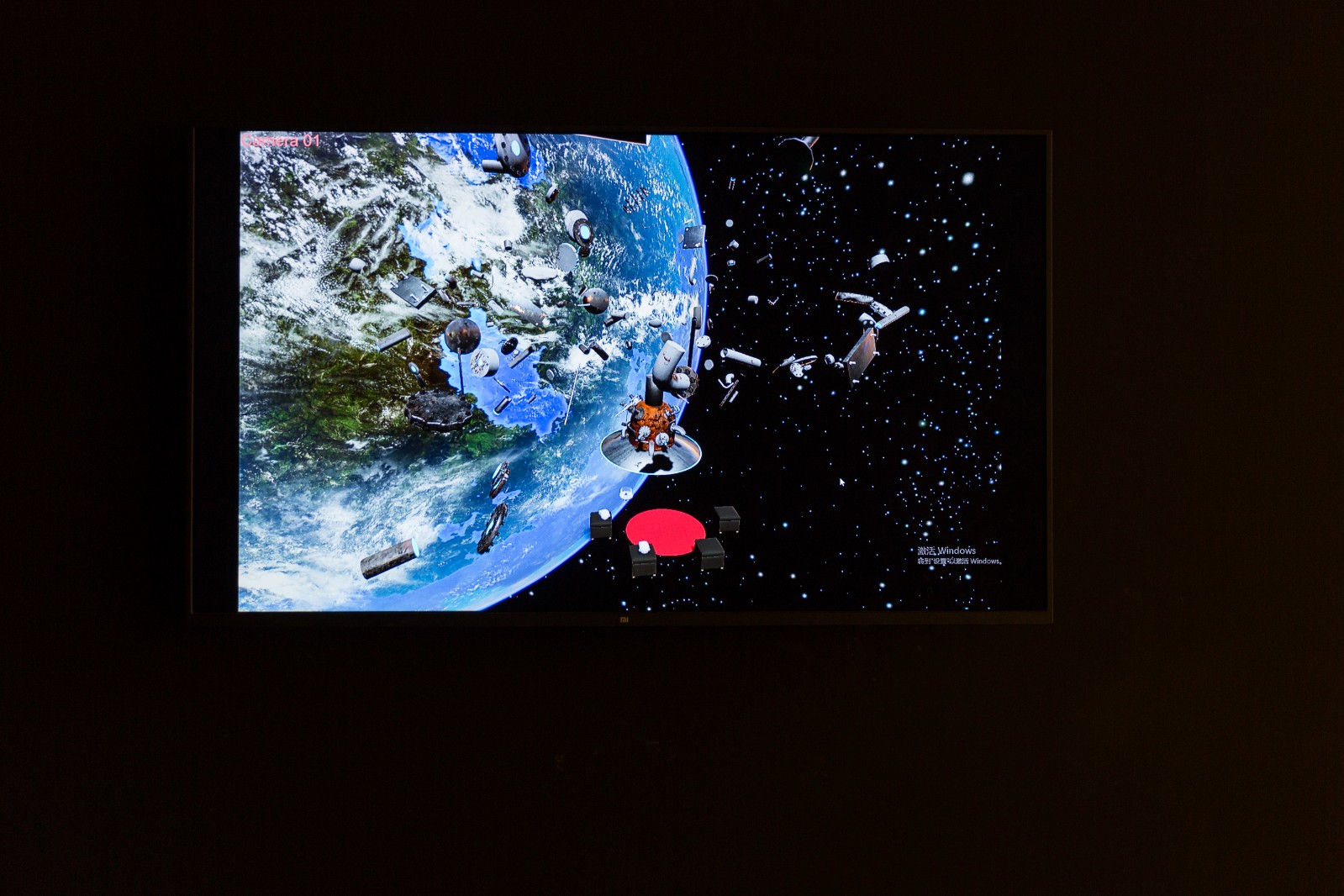
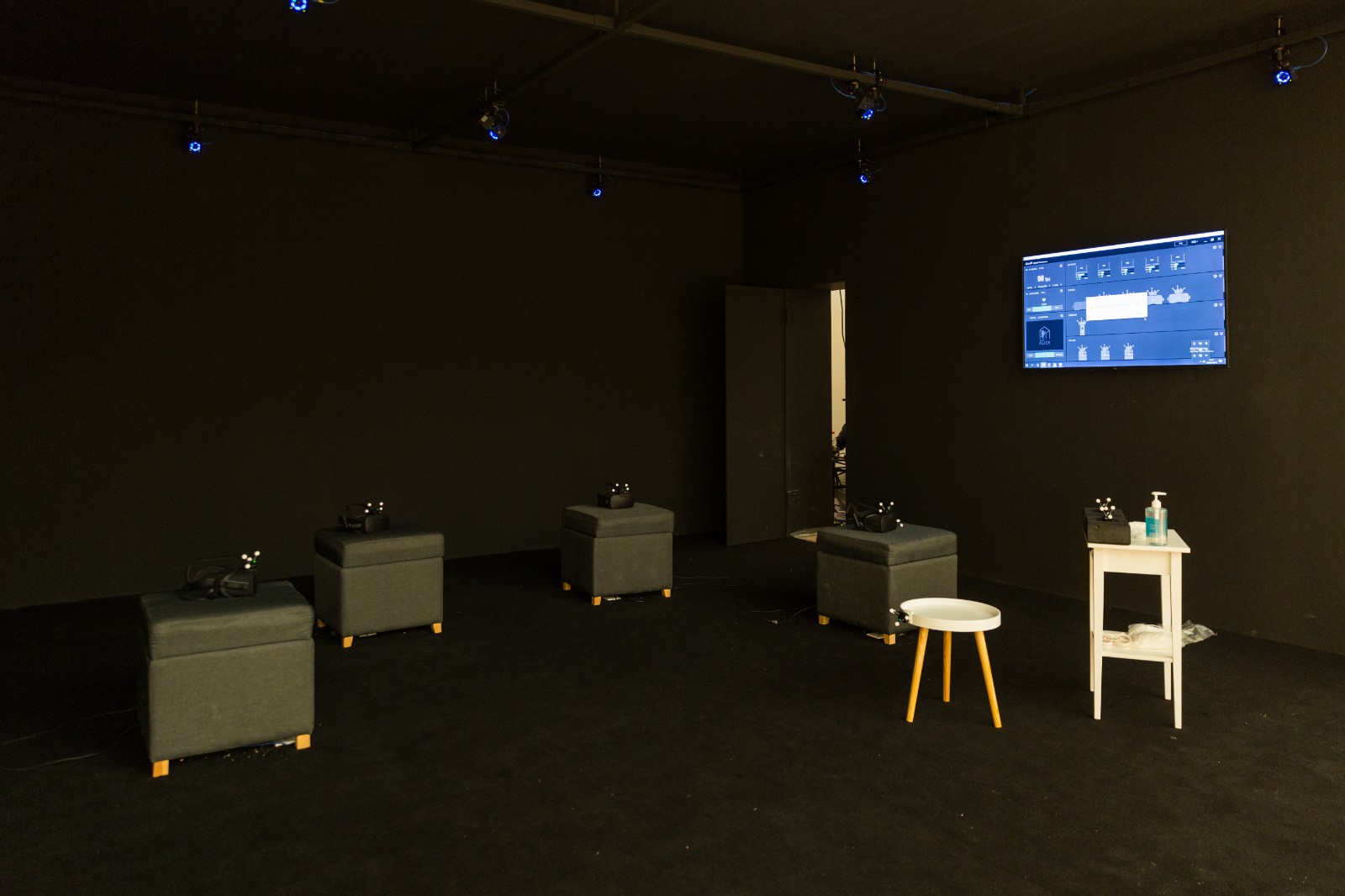
View of the VR Experiencing Hall
CAFA ART INFO: Recently, you have served as Deputy Secretary of the Party Committee and Vice President of Jingdezhen Ceramic Institute. As you assume your new position, what plans and expectations do you have for future creations and teaching?
Lv Pinchang: Jingdezhen, a thousand-year-old town and the world’s porcelain capital, is full of culture, history and stories. Jingdezhen Ceramic Institute is my alma mater. With new positions, new environments, and new missions, we face the coexistence of opportunities and challenges, as well as pressure and motivation. “Pressure” stems from the long way to go in the inheritance of a ceramic culture. Based on the inheritance of a ceramic culture, we need to do a lot of work and shoulder the major mission of national cultural development and prosperity. This is the historical burden of inheriting Chinese traditional culture. The “motivation” lies in the strong support of the national cultural strategy and policy, the encouragement by the seniors in Jingdezhen and the Chinese art field and the unity of the local art colleagues in Jingdezhen. All these factors will become the driving force for my new work. Confronting the historical opportunity that the country attaches to the great importance of the inheritance and development of traditional culture, we will carry out a full range of talent training around the discipline of construction with “ceramics” as the core, and complete the innovative development and creative transformation of traditional superior disciplines.
Regarding the teaching field, we will continue to deepen and strengthen the subject of the theory of the history of ceramics to realize the establishment of a historical theory system centered on Chinese traditional crafts and theory on contemporary ceramics from the theoretical level in the true sense. Besides, I also plan to improve the Institute in terms of exhibition planning and strategy by constructing a brand-new art museum and building a multi-level exhibition space for art achievements. By doing so, I intend to provide a complete display platform for teaching in schools, art promotion and academic research. The art museum will introduce international exhibitions with high academic standards, first-class exhibition effects and solid theoretical research. Also, the ceramic branded exhibitions will contain a high degree of education and the potential for significant influence will be curated to support the museum. Thus, a complete system with functions such as teaching, exhibitions, academic seminars and art collections is formed.
In terms of personal creations, I can imagine that my time for creation will be compressed to a great extent, but it has always been the normal rhythm of my creative life to persist in creating while I am busy at work. The transformation between work and creation can also promote my deeper thinking, re-examining my own work between different perspectives and identities. More consideration and use of ceramic materials in the current situation can help to expand its greater potential and possibilities.



Exhibition View
Text and Interview conducted by Emily Weimeng Zhou
Edited by Sue/CAFA ART INFO
Exhibition View by Hu Sichen
Images of Artworks Courtesy of the Organizer
Note:
[1] According to the exhibition materials, we adopt “Lv” rather than “Lyu” as the artist’s surname translation.
[2] The translation of “Woyou”(CN. 卧游) is referenced from the official website of The Palace Museum.
https://en.dpm.org.cn/collections/collections/2010-03-24/1283.html
Accessed on Oct. 21st, 2020.
About The Exhibition

CAFA Annual Fine Arts Nomination Exhibition 2020:
Qi Xiang/Zhi Xiang - Ma Lu & Lv Pinchang
Academic Director: Fan Di’an
Exhibition Director: Wang Yingsheng Zhang Zikang
Curator: Hongmei
Curatorial Assistant: Xu Xinchen Gao Na Zhang Qianyuan
Duration: 2020.10.17-2020.11.01
Venue: Ground Floor, Gallery 3A & 3B, CAFAM
Organizer: Central Academy of Fine Arts


